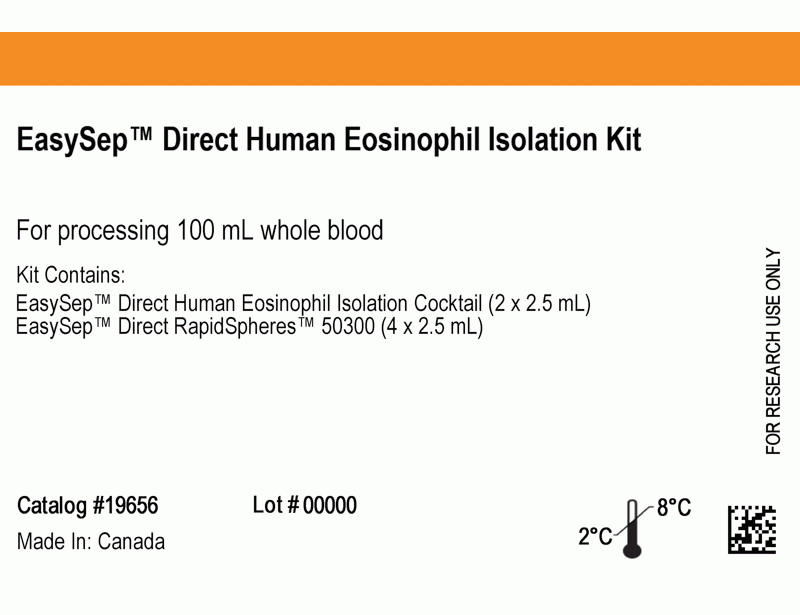EasySep™ Direct Human Eosinophil Isolation Kit
Immunomagnetic negative selection from whole blood kit
概要
The EasySep™ Direct Human Eosinophil Isolation Kit isolates functional, highly purified eosinophils directly from human whole blood by immunomagnetic negative selection. No lysis, density gradient centrifugation, or other processing steps are required and isolated cells are immediately available for flow cytometry, functional assays, culture, and other downstream applications.
Advantages
• Effectively depletes RBCs without the need for density gradient centrifugation, sedimentation, or lysis
• Up to 98% purity of isolated cells
• Fast, easy-to-use and column-free
• Isolated cells are untouched
• Up to 98% purity of isolated cells
• Fast, easy-to-use and column-free
• Isolated cells are untouched
Components
- EasySep™ Direct Human Eosinophil Isolation Kit (Catalog #19656)
- EasySep™ Direct Human Eosinophil Isolation Cocktail, 2 x 2.5 mL
- EasySep™ Direct RapidSpheres™ 50300, 4 x 2.5 mL
Magnet Compatibility
• “The Big Easy” EasySep™ Magnet (Catalog #18001)
• Easy 50 EasySep™ Magnet (Catalog #18002)
• EasyEights™ EasySep™ Magnet (Catalog #18103)
Subtype
Cell Isolation Kits
Cell Type
Granulocytes and Subsets
Species
Human
Sample Source
Whole Blood
Selection Method
Negative
Application
Cell Isolation
Brand
EasySep
Area of Interest
Immunology
技术资料
| Document Type | 产品名称 | Catalog # | Lot # | 语言 |
|---|---|---|---|---|
| Product Information Sheet | EasySep™ Direct Human Eosinophil Isolation Kit | 19656 | All | English |
| Safety Data Sheet 1 | EasySep™ Direct Human Eosinophil Isolation Kit | 19656 | All | English |
| Safety Data Sheet 2 | EasySep™ Direct Human Eosinophil Isolation Kit | 19656 | All | English |
数据及文献
Data

Figure 1. Typical EasySep™ Direct Human Eosinophil Isolation Profile
Starting with human whole blood from normal healthy donors, the typical eosinophil (CD16-CD66b+) content of the non-lysed final isolated fraction is 95.8 ± 2.7% (gated on CD45). In the above example, the eosinophil content of the lysed whole blood start sample and the non-lysed final isolated fraction is 2.3% and 97.6% (gated on CD45), respectively, or 2.2% and 90.8% (not gated on CD45), respectively.
Publications (1)
Respiratory research 2019 oct
Neutrophils from severe asthmatic patients induce epithelial to mesenchymal transition in healthy bronchial epithelial cells.
Abstract
Abstract
BACKGROUND Asthma is a heterogenous disease characterized by chronic inflammation and airway remodeling. An increase in the severity of airway remodeling is associated with a more severe form of asthma. There is increasing interest in the epithelial to mesenchymal transition process and mechanisms involved in the differentiation and repair of the airway epithelium, especially as they apply to severe asthma. Growing evidence suggests that Epithelial-Mesenchymal transition (EMT) could contribute to airway remodeling and fibrosis in asthma. Severe asthmatic patients with remodeled airways have a neutrophil driven inflammation. Neutrophils are an important source of TGF-$\beta$1, which plays a role in recruitment and activation of inflammatory cells, extracellular matrix (ECM) production and fibrosis development, and is a potent inducer of EMT. OBJECTIVE As there is little data examining the contribution of neutrophils and/or their mediators to the induction of EMT in airway epithelial cells, the objective of this study was to better understand the potential role of neutrophils in severe asthma in regards to EMT. METHODS We used an in vitro system to investigate the neutrophil-epithelial cell interaction. We obtained peripheral blood neutrophils from severe asthmatic patients and control subjects and examined for their ability to induce EMT in primary airway epithelial cells. RESULTS Our data indicate that neutrophils from severe asthmatic patients induce changes in morphology and EMT marker expression in bronchial epithelial cells consistent with the EMT process when co-cultured. TGF-$\beta$1 levels in the culture medium of severe asthmatic patients were increased compared to that from co-cultures of non-asthmatic neutrophils and epithelial cells. CONCLUSIONS AND CLINICAL RELEVANCE As an inducer of EMT and an important source of TGF-$\beta$1, neutrophils may play a significant role in the development of airway remodeling and fibrosis in severe asthmatic airways.


